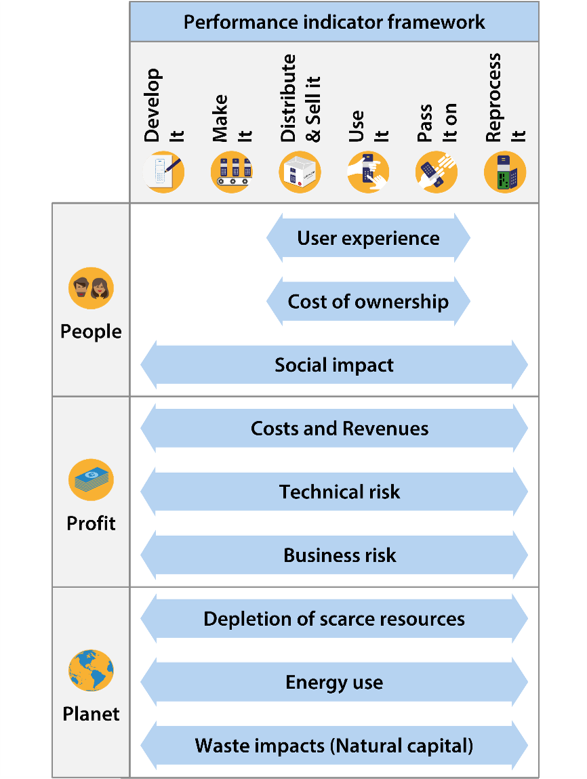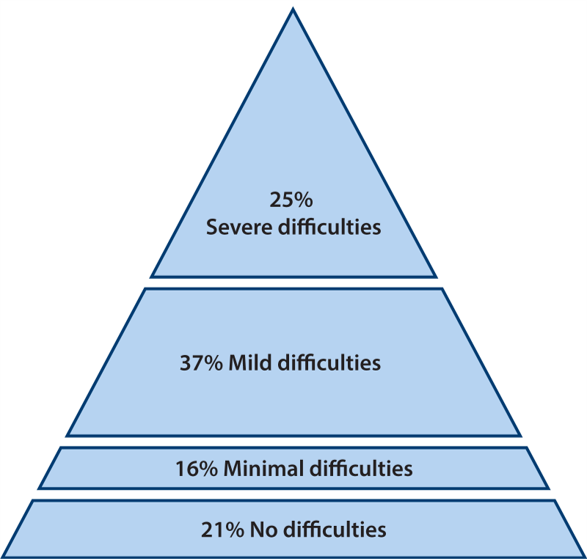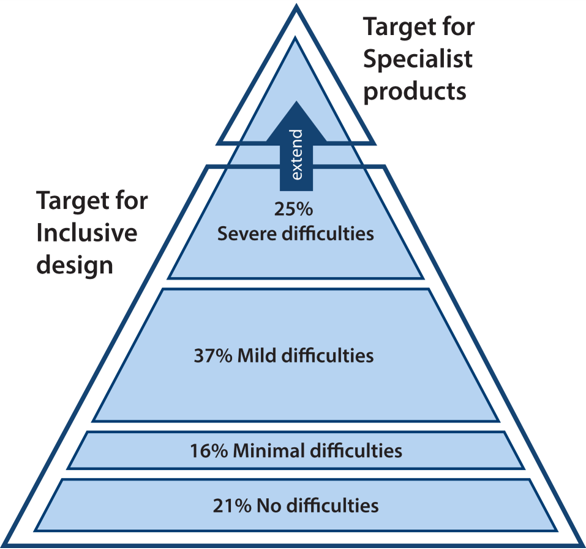The British Standards Institute defines inclusive design as:
“
The design of mainstream products and/or services that are accessible to, and usable by, as many people as reasonably possible ... without the need for special adaptation or specialised design. ”
In summary, every design decision has the potential to include or exclude customers. Inclusive design is about making informed design decisions, by better understanding user diversity, which helps to include as many people as possible. User diversity covers variation in capabilities, needs and aspirations.
This page first presents an example set of ‘Product performance indicators’, i.e. things that should be considered when thinking about how well a product or service is performing. It discusses how users’ needs fit into this set. It then explains how delivering breakthrough advances across the whole set of performance indicators requires understanding diversity within the population and responding to this diversity through Inclusive design. Comparisons with ‘Design for all’ and ‘Universal design’ are also presented.
On this page:
Product performance indicators
Inclusive design focuses on the diversity of people and the impact of this on design decisions. However, the complete set of performance indicators should consider a wider set of aspects concerned with People, Profit and Planet, as described in the ‘Performance indicator framework’ diagram shown opposite.
The performance indicators should examine how the different aspects have an impact across the whole life-cycle of the product. This life-cycle typically involves the stages:
- Develop it
- Make it
- Distribute & sell it
- Use it
- Pass it on
- Reprocess it
For most current products, the user ‘Passes it on’ by throwing it in the bin, and ‘Reprocess it’ involves storage in landfill. However, recycling and refurbishment represent other alternatives for these stages.
These performance indicators are described in more detail within the Designing Our Tomorrow business website.
Understanding user diversity
Failure to correctly understand people can result in products that cause unnecessary frustration and exclusion, which reduces commercial success because of increased returns and customer support.
In order to better understand population diversity, it is important to challenge the polarised separation of ‘able-bodied’ and ‘disabled’. Research commissioned by Microsoft (2003) to investigate the benefit of accessible technology makes the following comment:
“
The concept of "disability" may have limited the understanding of the need for accessible technology ... the IT industry must consider the wide range of people who could benefit. ”
Diversity within the population is better modelled using a pyramid to model the full range of ability variation within a population. This pyramid can then be segmented to identify various categories of users. The bottom segment of the pyramid represents those with no difficulties, and the severity of difficulties increases up the pyramid. A specific interpretation of this pyramid model is shown opposite.
Population diversity has been introduced first from the perspective of ability variation, but can be further broadened to consider diversity associated with different real-world contexts, lifestyle, aspirations, gender, and past experiences. In summary, ‘it’s normal to be different’ (Lange and Becerra, 2007).
Further information
- A report by Microsoft (2003) (downloads a Word doc): The Wide Range of Abilities and its Impact on Computer Technology presents survey results on the range of abilities in the US population and discusses the current and potential market for accessible technology.
- A paper by Lange and Becerra (2007): Teaching universal design in Colombia: the academic approach of two universities discusses perceptions of disability and explains how it is ‘normal to be different’.
Definition of inclusive design
The British Standards Institute (2005) defines inclusive design as:
“
The design of mainstream products and/or services that are accessible to, and usable by, as many people as reasonably possible ... without the need for special adaptation or specialised design. ”
Inclusive design does not suggest that it is always possible (or appropriate) to design one product to address the needs of the entire population. Instead, inclusive design guides an appropriate design response to diversity in the population through:
- Developing a family of products and derivatives to provide the best possible coverage of the population.
- Ensuring that each individual product has clear and distinct target users.
- Reducing the level of ability required to use each product, in order to improve the user experience for a broad range of customers, in a variety of situations.
Our work with Essity showcases one commercially successful example of inclusive design, where improved e-commerce images helped to increase sales by up to 29%.
Further information
The British Standards Institute (2005) standard BS 7000-6:2005: ‘Design management systems - Managing inclusive design’ defines inclusive design and provides guidance on managing it. It can be purchased from the BSI website.
Comparison with ‘Universal design’
‘Design for all’ and ‘Universal design’ philosophies both have the same literal meaning. These philosophies originated from design of the built environment and websites, and were initially applied in the context of government provision (from the Universal Design Handbook and the Design for All Foundation website).
In the context of product design, both ‘Design for all’ and ‘Universal design’ approaches pragmatically accept that it is not always possible for one product to meet the needs of the entire population. Nevertheless, these approaches maintain that all mainstream products should be accessible to as many people as technically possible (from the Universal Design Handbook).
In contrast, inclusive design originated with product design, and focuses on choosing an appropriate target market for a particular design, and making informed decisions to maximise the ‘Product performance indicators’ for that target market.
While all three approaches aim to extend the reach of mainstream products, inclusive design more readily acknowledges the commercial constraints associated with satisfying the needs of the target market.
For websites and the built environment, the target population is generally the whole population, in which case all three approaches have an equivalent meaning.
Further information
- The Universal Design Handbook by Preiser and Ostroff gives more information about universal design.
- The Inclusive Design Research Centre website has a section on What is inclusive design?, which also discusses similarities and differences between inclusive and universal design.
Next steps
Now that you have read the basic introduction to inclusive design, you might like to:
- Read more about Why do inclusive design? and Who wrote this toolkit.
- Sign up for one of our Training workshops.
- Commission our Consultancy services
Our consultancy services can audit your products and calculate population exclusion.
Feedback
We would welcome your feedback on this page:
Privacy policy. If your feedback comments warrant follow-up communication, we will send you an email using the details you have provided. Feedback comments are anonymized and then stored on our file server. If you select the option to receive or contribute to the news bulletin, we will store your name and email address on our file server for the purposes of managing your subscription. You can unsubscribe and have your details deleted at any time, by using our Unsubscribe form. If you select the option to receive an activation code, we will store your name and email address on our fileserver indefinitely. This information will only be used to contact you for the specific purpose that you have indicated; it will not be shared. We use this personal information with your consent, which you can withdraw at any time.
Read more about how we use your personal data. Any e-mails that are sent or received are stored on our mail server for up to 24 months.







